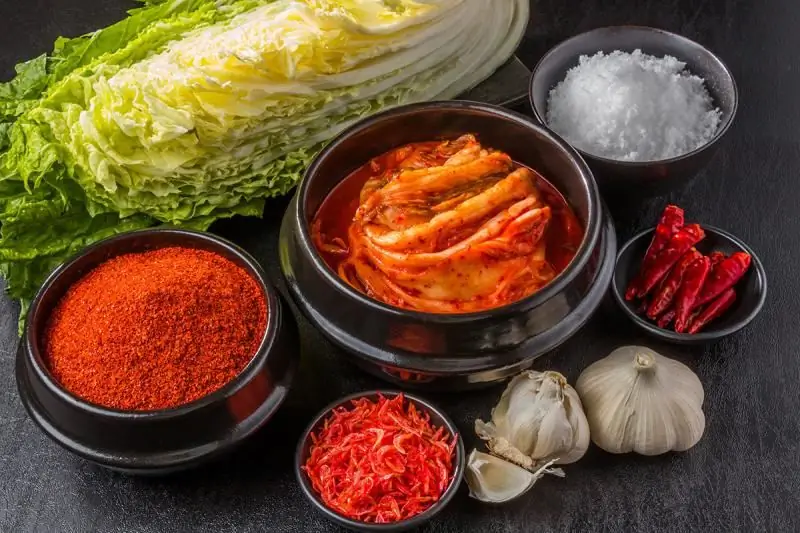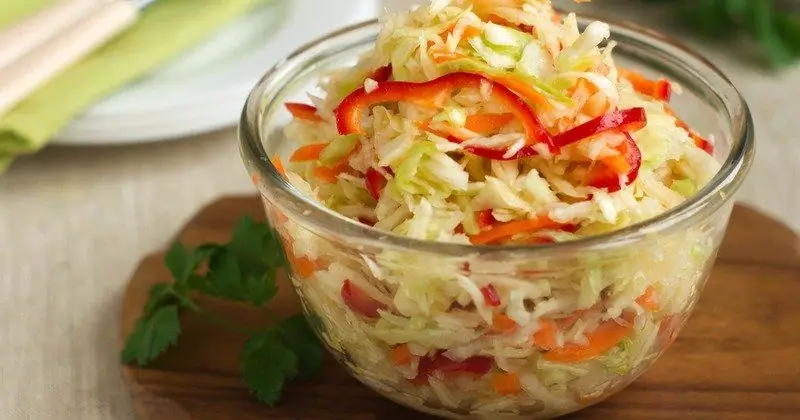
Table of contents:
- Author Bailey Albertson [email protected].
- Public 2023-12-17 12:53.
- Last modified 2025-06-01 07:32.
Spicy kimchi: Korean style Chinese cabbage recipes

Kimchi is a popular Korean food that has become one of the symbols that perfectly embodies its culture. In Korea, this dish is considered the main one, since it is dietary, burns fat, strengthens the immune system, and helps in the fight against colds and hangovers. Depending on the ingredients, the food's geographic origin and the season, kimchi is prepared differently. The most common dish is Chinese cabbage.
Content
-
1 Basic Peking Cabbage Kimchi Recipe
1.1 Video: how to cook traditional kimchi
-
2 Kimchi with shrimps and green onions
2.1 Video: Korean cabbage kimchi
-
3 Kimchi with red fish and Chinese pears
3.1 Video: how to cook Chinese cabbage kimchi
Basic Chinese cabbage kimchi recipe
I started my acquaintance with the process of preparing the incomparable Korean food with the recipe, which I will describe below. I knew that the classic version assumes the presence of a larger number of different ingredients, but this method bribed me with its simplicity, and later it made me happy with the results.
Ingredients:
- 3 kg of Chinese cabbage;
- 100 g of garlic;
- 30 ml of sunflower oil;
- 6 liters of water;
- 6 tbsp. l. salt;
- 100 g ready-made mixture of dried paprika, coriander and hot red pepper.
Cooking steps:
-
Rinse the heads of Chinese cabbage under cold running water and cut in half lengthwise.

Peking cabbage, cut in half For pickling, choose fresh and crispy cabbage.
-
Transfer the cabbage to a large saucepan.

Large bowl of Chinese cabbage halves For salting, you can use an enamel pan or stainless steel container
-
Prepare brine by mixing salt and water.

Salt in a tablespoon over a plate Use coarse salt and be careful to completely dissolve the crystals in the water
-
Pour the brine over the cabbage, put oppression on top and leave in a warm place for 2 days.

Peking cabbage in a large saucepan under yoke You can use a large plate and a jar of water as oppression.
- After the indicated time, drain the liquid.
-
Pour the seasoning mixture into a bowl, pour 1 cup boiling water, let stand for 10 minutes.

Steaming dry seasonings with boiling water Thanks to boiling water, dry seasonings will swell, and also activate their taste and aroma
-
Chop the peeled garlic cloves.

Chopping garlic with a blender Garlic can be chopped in a blender or chopped very finely with a knife
-
Pour refined sunflower oil into the seasoning mixture.

Adding sunflower oil to the seasoning mixture The best option for refueling is odorless sunflower oil
-
Add chopped garlic to the dressing.

Chopped garlic in a bowl with a mixture of spices Garlic will give the dish a special aroma and taste.
-
Mix all ingredients thoroughly.

Mix of herbs and garlic in a bowl To obtain the required consistency, stir the dressing for at least 2 minutes
-
Opening the cabbage layers slightly, coat each Peking leaf well with the hot mixture.

Coating Chinese cabbage leaves with spicy dressing Grease the cabbage leaves gently so as not to break the bases of the heads
-
Place the cabbage halves tightly in a suitable container, cover and leave again for 2 days.

Peking cabbage with spicy dressing Turn the cabbage halves every 6-8 hours to soak the cabbage evenly.
- Transfer the finished snack to a plastic container with a tight-fitting lid and place in the refrigerator. The shelf life of the product is 2 weeks.
-
Before serving, cut the cabbage into small pieces and lightly drizzle with vegetable oil.

Kimchi on a plate Serve the cabbage, cut into pieces beforehand
Video: how to cook traditional kimchi
Kimchi with shrimps and green onions
I confess that this recipe has not yet been tested by me personally. More precisely, I was lucky enough to enjoy the taste of traditional kimchi, but I don't have enough time to cook it myself. It so happened that about 15 years ago, 3 Korean families settled on our street at the same time. We met and often invited each other to visit, not forgetting to put on the table dishes typical of our people. Shrimp kimchi was the best I had to taste in those days.
Ingredients:
- 3 kg of Chinese cabbage;
- 100 g of salt;
- 400 ml of water;
- 2 tbsp. l. rice flour;
- 2 tbsp. l. Sahara;
- 200 g of white radish;
- 100 g carrots;
- 7-8 feathers of green onions;
- 20 cloves of garlic;
- 2 tsp grated ginger;
- 1 onion;
- 120 ml fish sauce;
- 50 g pickled shrimp;
- 300 g kochukaru pepper.
Cooking steps:
-
Cut the washed and dried heads of Peking cabbage with a sharp knife at the base, as shown in the picture below.

Peking cabbage cutting To maintain a neat look, cut the cabbage with a well-sharpened knife.
-
Gently, so as not to tear the delicate leaves, divide the heads of cabbage into 2-4 parts.

Splitting Peking Cabbage into Pieces Separate the cabbage pieces so as to keep the leaves intact as much as possible
-
Lightly wetting the sheets with water, brush them with salt.

Salting cabbage leaves Use more salt in the thicker parts of the leaves
-
Transfer the workpiece to a large container and leave for 2-2.5 hours.

Chinese cabbage leaves in a large deep plate Turning the vegetable over every few hours will ensure even salting.
-
Rinse the leaves well under running water, rinsing off the salt.

Washing cabbage from salt When washing the cabbage, pay attention to completely remove the remaining salt.
- Cut off the coarse lower parts of the heads of cabbage and divide the cabbage into pieces, 2-3 leaves together.
- Rub the peeled radish and carrots on a grater so that you get thin long straws.
- Pass the garlic through a press.
-
Grate the onion, finely chop the green onion feathers and shrimp with a sharp knife.

Shrimp shrimp Canned or boiled seafood can be used as a snack
- Pour rice flour into a saucepan, cover with water, stir. Heat the mixture to a boil, add 1 tbsp. l. granulated sugar, boil for a minute. Remove the gruel from the stove and let it cool.
- Place chopped garlic, ginger and onion in a bowl.
-
Add shrimp.

Making kimchi sauce Mix sauce ingredients in a convenient high-sided bowl
-
Pour in the fish sauce and add the kochukara pepper.

Korean kochukaru pepper in bowl with kimchi dressing Pepper kochukaru will give the dish a unique touch, inherent only in Korean cuisine
-
Mix all ingredients well.

Shrimp kimchi dressing Stir the sauce for 3-4 minutes
-
Put the vegetables and green onions in the bowl with the dressing, mix everything again.

Grated radish, carrots and kimchi dressing Mix the ingredients of the dressing so that the spice mixture completely covers the pieces of vegetables
-
Put the resulting paste on the sheets of Chinese cabbage and spread evenly over the entire surface.

Coating Chinese cabbage leaves with a mixture of spices, fish sauce and vegetables Thoroughly coat each cabbage leaf, applying the paste on both sides
-
Roll the sheets into rolls and place tightly in a large jar, saucepan, or any other suitable container.

Korean style Chinese cabbage, rolled into a roll When forming cabbage rolls, do not twist them too much so as not to damage the fragile leaves
-
Leave the snack in a warm place for 2-3 days, then move it to the refrigerator and store for no more than 3 weeks.

Korean style Chinese cabbage with shrimps in a bowl Before serving, kimchi can be sprinkled with sesame seeds
Video: Korean cabbage kimchi
Kimchi with red fish and Chinese pears
Another wonderful, in my opinion, version of kimchi. I have not tried or prepared this dish, but just from just one list of its constituent products and delicious photos, there is a great desire to enjoy this dish.
Ingredients:
- 1 head of Chinese cabbage;
- 1 radish;
- 2-3 Chinese pears;
- 50 ml fish sauce;
- 200 g ready-made kimchi sauce;
- 3 cm of ginger root;
- 50 g of salt;
- 10 g granulated sugar;
- 50 g of Korean adjika yannem;
- 100 g salted red fish.
Cooking steps:
-
Prepare the food you need.

Products for kimchi with pears and radish To prepare kimchi, use white radish such as daikon or forehead
- Cut a head of cabbage weighing about 2 kg in half, rinse under running water and shake gently.
- Mix salt and sugar.
-
Gently bending the cabbage leaves, brush them on all sides with a salt mixture.

Half a head of Chinese cabbage with salt The thick base of cabbage heads requires an increase in the soybean layer
- Place the cabbage in a deep container and place under the oppression no more than 5 kg. Leave it in a warm place overnight.
- Cut the peeled pears and radish into thin slices. Cut the washed and dried green onion feathers into 3-5 cm pieces.
-
Combine fruits and vegetables in a large bowl, add yangnem and fish sauce.

Pieces of white radish, pears and green onions Green onions can be cut into long strips or finely chopped with a knife
- In the morning or a day after salting, rinse the cabbage from salt.
-
Grate the ginger root on a fine grater and mix with the kimchi sauce.

Kimchi sauce, ginger and green onions on the table Ready-made kimchi sauce can be purchased from Asian food departments or online.
-
Finely chop a piece of red fish without bones and skin with a knife and mix with ginger paste.

Slice of salted red fish For a snack, salmon, salmon, pink salmon or any other salted fish of red varieties are suitable
- Thoroughly coat all the Chinese cabbage leaves with the prepared sauce and layer with a mixture of pears, radishes and green onions.
- Place the halves of the heads of cabbage in a suitable container and leave under yoke for 2 days.
-
After 2 days, transfer the snack to a tightly resealable container or saucepan and refrigerate. After a week, the kimchi is ready to eat.

Kimchi with red fish Chimchi with red fish and pears is a great appetizer for any table
And I also want to offer you another interesting version of kimchi, which includes vegetables, fruits and seaweed.
Video: how to cook Chinese cabbage kimchi
I'm sure there are also Korean food fans among our readers who will tell us about their wonderful kimchi recipes. We are waiting for your stories about cooking a delicious, healthy and incredibly appetizing dish in the comments below. Enjoy your meal!
Recommended:
Lazy Stuffed Cabbage: Step By Step Recipes With Photos, In The Oven And In A Pan, With Rice And Minced Meat, Cabbage, In Sour Cream Sauce

How to cook delicious and satisfying lazy cabbage rolls. Step by step recipes, tips and tricks
Chicken Breast And Chinese Cabbage Salad: A Simple Step-by-step Recipe With Photos And Videos

How to make a salad with chicken breast and Chinese cabbage. Step-by-step instructions with photos and videos
Delicious And Simple Salads With Chicken Breast: Step-by-step Recipes With Mushrooms, Corn, Korean Carrots, Celery, Mushrooms, Photo

How to cook chicken breast salads. Step by step recipes
Delicious Pickled Cabbage Instant: Step By Step Recipes With Photos

How to cook quick pickled cabbage. Step-by-step recipes with photos and videos
Sausages In Cabbage: Recipes For Lazy Cabbage Rolls In 5 Minutes, Photos And Videos

Step-by-step recipe for lazy cabbage rolls, or sausages in cabbage, with photos and videos
